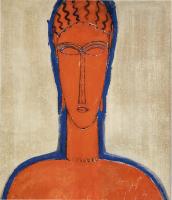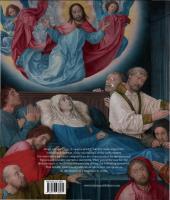Hugo van der Goes. Between Pain and Bliss. Exhibition catalog of Berlin Gemäldegalerie 3777438472, 9783777438474
Along with Jan van Eyck and Rogier van der Weyden, Hugo van der Goes is one of the most important and influential Nether
153 39 170MB
English Pages 304 [292] Year 2023
Cover
Contents
Foreword and acknowledgments
Lenders
Hugo van der Goes: The loss and rediscovery of an extraordinary artist
Hugo van der Goes in archival perspective
A painter in the Burgundian Netherlands: Hugo van der Goes and his connections
Hugo van der Goes and the followers of Rogier van der Weyden
Mental illness, the Devotio Moderna, and the Vienna Diptych
Painter-monks and artists in the monastery
Hugo van der Goes’ approach to portraiture
Hugo van der Goes as a draftsman
Hugo van der Goes and his followers
Hugo’s madness
The Portinari Altarpiece
The Trinity Panels
Catalogue
Recommend Papers
File loading please wait...
Citation preview
u vander Between Pain and Bliss
For the Gemaldegalerie - Staatliche Museen zu Berlin edited by Stephan Kemperdick and Erik Eising with the collaboration ofTill-Holger Borchert
Gemaldegalerie Staatl iche Museen zu Berl in
HIRMER
DAGMAR HIRSCHFELDER
ERIK EISING
Foreword and Acknowledgments
Hugo van der Goes and the Followers of Rogier van der Weyden
6
35
Lenders 8
STEPHAN KEMPERDICK
BERNHARD RIDDERBOS
Hugo van der Goes: The Loss and Rediscovery of an Extraordinary Artist
Mental Illness, the Devotio Moderna, and the Vienna Diptych
11
.
45
JAN DUMOLYN AND ERIK VERROKEN
KATRIN DYBALLA
WITH THE COLLABORATION OF TILL-HOLGER BORCHERT
Painter-Monks and Artists in the Monastery
Hugo van der Goes in Archival Perspective
49
19
STEPHAN KEMPERDICK
MARYAN W. AINSWORTH
A Painter in the Burgundian Netherlands: Hugo van der Goes and His Connections
Hugo van der Goes' Approach to Portraiture
25
55
STEPHANIE BUCK
LORNE CAMPBELL
Hugo van der Goes as a Draftsman
The Trinity Panels 99
63
TILL-HOLGER BORCHERT
Hugo van der Goes and His Followers
Catalogue 109
71
GREGOR WEDEKIND
Hugo's Madness
Bibliography
81
281
Image Credits 302
Imprint EMMA CAPRON
The Portinari Altarpiece 89
304
DAGMAR HIRSCHFELDER
Foreword and Acknowledgments
A
long with Jan van Eyck and Rogier van der Weyden, Hugo van der Goes is one of the most important and influential Netherlandish artists of the fifteenth century. Like his great predecessors, he also invented new, poignant compositions and figures that were influential for decades. Hugo's surviving oeuvre, however, is small. Today, only about thirteen painted works and two drawings are attributed to his hand-very few, even compared to the twenty or so surviving works of Jan van Eyck and the nearly forty of Rogier van der Weyden. Yet in terms of size, Hugo's most important works far exceed the dimensions common in his day. The central panel of his Portinari Altarpiece is by far the largest Netherlandish panel painting of the century. That the monumental and intensely colorful effect of the Monforte Altarpiece's central panel, today in Berlin, constitutes a clear departure from the tradition of older Netherlandish art, is vividly illustrated by the fact that in the nineteenth century, when it was still in Monforte, Spain, it was considered a work by Peter Paul Rubens, the great master of Baroque painting who was born about a hundred years after Hugo's death. The unusually large format of Hugo van der Goes' works is also the reason why he is the only one of the great Netherlandish artists of his period who has not previously been the subject of a monographic exhibition. The very large-scale works-one in Florence, one in Edinburgh, two in Berlin-cannot travel for reasons of conservation. The Gemaldegalerie of the Staatliche Museen zu Berlin boasts the highest concentration of works by Hugo van der Goes, including two of the large panels, a tiichlein by his own hand, as well as an only slightly more recent copy after a lost composition by the master. Today they are one of the focus areas of the preeminent Berlin collection of early
6
Netherlandish paintings. Unlike most of the major pieces in the collection, which were acquired in the museum's pioneering days of the nineteenth century, the three works by van der Goes came to the Berlin museums in quick succession, first in 1900, then in 1902 and 1913. Only the copy of an Adoration of the Magi by Hugo van der Goes had been purchased as early as 1821, with the Solly collection, though at the time it was considered a work by Hans Memling. By 1900, however, knowledge of and interest in Hugo van der.Goes' work had grown significantly, making it all the more astonishing that it proved possible to acquire three such high-quality works. First the tiichlein entered the collection as a gift of Oscar Huldschinsky, a prominent member of the Kaiser Friedrich Museumsverein. The two large-scale panels, on the other hand, were purchased at the instigation of Max J. Friedlander and Wilhelm Bode, although possession could be taken of the Monforte Altarpiece only after several years of negotiations with the Spanish government. At a price of almost one million Reichsmarks, it was the most expensive acquisition to date in the history of the Gemaldegalerie. The attempt to mount an exhibition of Hugo van der Goes' work could be undertaken only at the Berlin gallery, as it already has two large, non-transportable panels by the artist. The project has met with a great deal of interest and support, and we are extremely grateful to the numerous colleagues and institutions who have agreed to lend their valuable works for our exhibition. As a result, it is now possible to present nearly the entire extant oeuvre of Hugo van der Goes-only the monumental panels in Florence and Edinburgh had to remain at their established locations. Various, often roughly contemporary, copies are shown in the place of some of the artist's major works that have not come down to us, including the long-lost top section
of the Monforte Altarpiece, a documented wall painting by Hugo destroyed in the early modern period, and a square-format Adoration of the Magi. preserved in several versions. Individual works of the painter's immediate followers, such as a triptych with the Martyrdom of Saint Hippolytus, complete the exhibition and accompanying catalogue. At the same time, this exhibition catalogue sees itself as an up-to-date monograph on Hugo van der Goes, the first since Elisabeth Dhanens' publication from 1998. For this reason, each of the two aforementioned non-lendable works are also discussed in short essays. Individual catalogue entries introduce readers to all of the artist's other works as well as paintings and drawings of his immediate circle and selected copies. In addition, ten essays by international experts examine the artist and his creations from different perspectives. Our first and most sincere thanks go to the Federal Government Commissioner for Culture and the Media for generously sponsoring the exhibition. We are also deeply indebted to our lenders for making their precious works available to us and thus making the exhibition possible. I would especially like to thank the curators of the exhibition, Stephan Kemperdick and Erik Eising, for their outstanding work. In addition, we would like to thank the authors of this catalogue and all those who have contributed to the planning and realization of the exhibition and catalogue, especially the staff of the Staatliche Museen zu Berlin and the Stiftung Preussischer Kulturbesitz, the architects and planners of the exhibition, and the staff of Hirmer Publishers. We thank the following people for their support and indispensable help: Frank Adam, Maryan W. Ainsworth, Marina Albeni, Laura Aldovini, Susanne Anger, Karen Angne, Michiko Bach, Katrin Basig, Sylvain Bellenger, Gabriella Belli, Andrea Bellieni, Ines Bellin, Jon Benington, Paula Binari, Julia Blanks, Jonathan Bober, Zuzana Bolerazka, Till-Holger Borchert, Francesca Bottacin, Bernard Bousmanne, Eefje Breugem, Laurence Brugger, Frederique Bruins, Barbara Buchbauer, Stephanie Buck, Roberto Buda, Veronique Bi.icken, Celine Bultreys, Jessica Buskirk, Quentin Buvelot, Joaquim Oliveira Caetano, Lisa Cain, Lorne Campbell, Susana Campos, Carlo Capponi, Emma Capron, Julien Chapuis, His Majesty King Charles III, Vincent Chauvet, Benedetta Chiesi, Martin Clayton, Faye Cline, Mary Cochran, Roberto Contini, Richard Dark, Brigitte de Bontin, Jessica De Coster, Lindy de Heij, Philipp Demandt, Dominique Deneffe, Dirk Desmet, Nelleke de Vries, Nina Diernhofer, Catrin Dietrich, Florentine Dietrich, Daniel Dolder, Thomas Doring, Michel Draguet, Beatrice Drengwitz, Jan Dumolyn, Katrin Dyballa, Adam Eaker, Martin Eberle, Lisa Eckstein, Maren Eichhorn, Michael Eissenhauer, Albert J. Elen, Her Majesty Queen Elizabeth II, Caroline EudeDevaux, Marijn Everaarts, Sjarel Ex, Kaywin Feldman, Gabriele Finaldi, Ramona Follmer, Matthias Forster, Susan Foister, Bart
Fransen, Mieke Fransen, Daniel Friedrich-Kockro, Fabian Frohlich, Sabine Frohmader, Carin_a Fryklund, Pablo Garcia Perez, Kerstin Gericke, Laura Goedert, Sibylla Goegebuer, Denise Gorlich, Martine Gosselink, Barbara Gottschalk, Beatrix Graf, Amy Graves, Jasha Greenberg, Elsa Guerreiro, Sabine Haag, Christina Haak, Valerie Haerden, Kazusa Haii, Anita Haldemann, Anne Harmssen, Jenn Harr, Babette Hartwieg, Sven Hauschke, Konstanze Hausstatter, Andreas Heese, Josef Helfenstein, Uwe Heuer, Joris Corin Heyder, Lisa Horstmann, Sabine Hoffmann, Max Hollein, Frederick Ilchman, Svea Janzen, Nuria Jetter, Liz Jolly, Zora Kachel, Marcus Kaiser, Bertram Kaschek, Tobias Katz, Laila Khayati, Alexander Klar, Peter Klein, Katja Kleinert, Alicja Knast, Stefanie Knoll, Tim Knox, Christine Kohler, Dagmar Korbacher, Olga Kotkova, Rebekka Krieger, Sabine Krieger, Mechtild Kronenberg, Benoit Labarre, Suzanne Laemers, Birgit Lamerz-Beckschafer, Sara Lammens, Justus Lange, Karen Lawson, Sandra Leandro, Audrey Lebioda, Julie Lenaerts, Jascha Lenz, Bertram Lorenz, Kerstin Ludolph, Lisa MacDougall, Monika Mahr, Lisa Malkowski, Julia MarciariAlexander, Dominique Marechal, Agathe Mathiaut-Legros, Luise Maul, Franziska May, Scot McKendrick, Christina Meckelnborg, Christien Melzer, Ariane Mensger, Guido Messling, Eva Michel, Janet Moore, Javier Moya Morales, Andrea Millier, Chris Murray, Susie Nash, Uta Neidhardt, Ha Mi Nguyen, Barbara O'Connor, Sumihiro Oki, Bram Opstelten, Anda Ortmann, Daniel Partridge, Ulrike Paul, Barbora Patockova, Sabine Penot, Jose Juan Perez Preciado, Susanna Pettersson, Patrizia Piscitello, Lauren Porter, Marie Postec, Laura Prins, Maria Reimelt, Tobias Renner, Catherine Reynolds, Thomas Richter, Bernhard Ridderbos, Angela Rietschel, Jim Riseley, Anja Robbel, Johannes Rof3ler, Cristina Roquette, Daniel Rosengarten, Ramona Roth, Neville Rowley, Julie Rowlins, Marta Ruffatto, Alessandra Rullo, Giovanni Russo, Corinna Salmen-Mies, Jochen Sander, Karin Sandstedt, Samantha Saward, Niels Schalley, Christoph Schmidt, Thomas Schmieder, Theresia Schmitt, Renate Schreiber, Klaus Albrecht Schroder, Shannon Schuler, Wolfgang Schwahn, Zahava Seewald, Christine Seidel, Margaux Shraiman, Annette Siegel, Ines Gaspar Silva, Anna Simon, Guenevere Souffreau, Joaneath Spicer, Carolin Stanneck, Ute Stehr, Maria Stein, Marie-Theres Steinke, Sandra Stelzig, Marion Stenzel, Griet Steyaert, Andreas Stolzenburg, Monika Strolz, Jeroen Stumpel, Detlev Tager, Matthew Teitelbaum, Jacqueline Thalmann, Hannah Thijs, Lauren Thompson, Matthias Ubl, Maya Urich, Katrijn Van Bragt, Katharina Van Cauteren, Joost Vander Auwera, Sven Van Dorst, Anne van Oosterwijk, Ariane van Suchtelen, Bart Vercauteren, Marc Vercnocke, Erik Verroken, Jorg Vollnagel, Morgan Wadsworth-Boyle, Katharine Wall, Joshua Waterman, Gregor Wedekind, Hilde Weissenborn, Rainer Wendler, Hannah Widgington, Tanja Wieczorek, Betsy Wieseman, Anja Wolf, Sigrid Wollmeiner, Stephan Wolohojian, Johann Zehentmaier, Maria Zielke, and Agnes Zsiros.
7
Lenders Austria
The Netherlands
Vienna, Albertina Vienna, Kunsthistorisches Museum Wien, Gemaldegalerie
The Hague, Mauritshuis Rotterdam, Museum Boijmans Van Beuningen
Belgium
Portugal
Anderlecht, Musees Maison d'Erasme & Beguinage / Erasmushuis & Begijnhof Musea Antwerp, The Phoebus Foundation Bruges, Kathedrale Kerkfabriek Sint-Salvator Bruges, Musea Brugge, Groeningemuseum Brussels, KBR Brussels, Musees royaux des Beaux-Arts de Belgique
Evora, Museu Nacional Frei Manuel do Cenaculo Lisbon, Museu Nacional de Arte Antiga
Spain
Granada, Fundaci6n Publica Andaluza Rodriguez-Acosta
Sweden Czech Republic
Stockholm, Nationalmuseum
Prague, National Gallery Prague Prague, Prague Castle Collections, Czech Republic Switzerland
Basel, Kunstmuseum Basel, Kupferstichkabinett France
Autun, Musee Rolin United l




![The Materiality of Mourning (Exhibition Catalog) [1. ed.]
9781891771699, 9780300222517](https://ebin.pub/img/200x200/the-materiality-of-mourning-exhibition-catalog-1nbsped-9781891771699-9780300222517.jpg)





